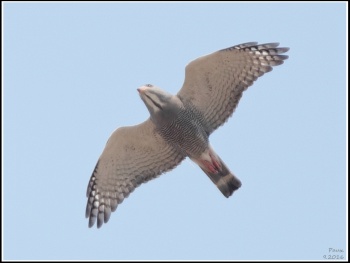- Kaupifalco monogrammicus
Identification
30–37 cm (11¾-14½ in)
- Grey upperparts, head and breas
- Black vertical black line on the white throat
- White belly with fine dark barring
- White underwings with dark tips
- Black tail with a white tip and a single white band
- Orangey-pink cere and legs
Sexes are similar.
Distribution
Africa south of the Sahara:
Western Africa: Senegal, The Gambia, Guinea-Bissau, Guinea, Mali, Liberia, Ivory Coast, Ghana, Togo, Benin, Nigeria, Niger, Chad, Cameroon, Central African Republic, Equatorial Guinea, Gabon, Democratic Republic of Congo, Angola, Zaire
Eastern Africa: Sudan, South Sudan, Ethiopia, Somalia, Kenya, Uganda, Rwanda, Burundi, Tanzania, Zambia, Mozambique, Malawi
Southern Africa: Namibia, Botswana, Zimbabwe, South Africa, KwaZulu-Natal, eSwatini
Taxonomy
Subspecies
There are two subspecies[1]:
- K. m. monogrammicus the northern race:
- Senegambia to Ethiopia, Uganda and Kenya
- K. m. meridionalis, the southern race:
- South Kenya to Angola, northern Namibia and northern South Africa
Habitat
Riverine forests and moist deciduous woodland.
Behaviour
Breeding
They build a stick nest in the fork of a tree or the crown of a palm tree. The clutch consists of 1-3 eggs.
Diet
Diet includes mainly reptiles, particularly lizards, large insects also small mammals and birds.
References
- Clements, J. F., T. S. Schulenberg, M. J. Iliff, D. Roberson, T. A. Fredericks, B. L. Sullivan, and C. L. Wood. 2016. The eBird/Clements checklist of birds of the world: v2016, with updates to August 2016. Downloaded from http://www.birds.cornell.edu/clementschecklist/download/
- Avibase
- Handbook of the Birds of the World Alive (retrieved October 2016)
Recommended Citation
- BirdForum Opus contributors. (2024) Lizard Buzzard. In: BirdForum, the forum for wild birds and birding. Retrieved 27 April 2024 from https://www.birdforum.net/opus/Lizard_Buzzard





